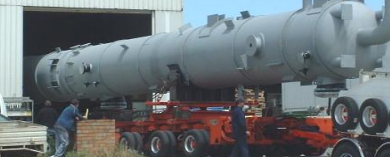
- (03) 5909 8218
- enquiry@fusionweld.com.au
Fracture Mechanics and Stress Analysis of Cracks in Pressure Vessels
December 1, 2017

The fundamentals of pressure vessel engineering are taking a break today as we turn our attention towards fracture mechanics. The theme of this entry targets crack stress analysis, a discipline that studies the permissible dimensions of a pressure vessel crack. In order to fully comprehend this science-based field of study, we need to understand some relatively complex metallurgical attributes, including the following theoretical concepts.
An Introduction to Fracture Mechanics
If we accept the fact that a crack can form on a pressure vessel, then we can use a scientific approach to study the manner in which these localized discontinuities will propagate. Essentially, it's the inter-granular characteristics of the rolled metal that decided just how these fractures develop. Weakened grain edges promote the fracture, the lattice-like structure then directs the fracture, and the cracks in the sheet metal develop like a staggered lightning bolt. Using fracture mechanics, there are special mathematical equations in place to predict what happens when that crack propagates.
Stress Analysis of Cracks
An energetic fluid medium applies directional force, the surface of the pressure vessel deforms, and the structure of the microcrystalline metal plating is tested to its limits. The mission of a stress analysis study is to establish those limits. Moreover, by validating those limits, the pressure vessels design specs are certain to match an applied fluid load. In terms of crack analysis, this scientific domain assesses the ways in which those stresses interact with the discontinuities we defined in the above paragraph. The discipline exhaustively investigates elastic stress, metal deformity, instances of fatigue, and applies this knowledge to how a fracture will affect the lattice boundaries in a rolled sheet metal segment. There are several theoretical models employed as a means of analyzing the way a crack reacts to internally generated stress, with crack-tip stress fields and crack-surface displacement profiles representing a key cross-section of this complicated engineering domain.
Fracture mechanics assesses how an energy field propagates in pressure vessel materials. An invisible manufacturing flaw inside the rolled alloy sheets presents a potential risk factor, one that could cause a surface discontinuity. If that cracking event is to be foiled, we use theoretical science to calculate how or even if the fracture will propagate. Paired with metallurgical knowledge and stress field data, the fracture mechanisms are predicted and addressed. From shear fractures to cleavage fractures, every propagating discontinuity is analyzed. Scientifically recognized in this manner, the fracture is evaluated so that its effects can be compared to any fluid loading scenario. In other words, we use this science to know when that permissible discontinuity could become a hazard.
Contact Details
Fusion - Weld Engineering Pty Ltd
ABN 98 068 987619
1865 Frankston Flinders Road,
Hastings, VIC 3915
Ph: (03) 5909 8218
Optimized by NetwizardSEO.com.au
Recent Posts
- Pressure Vessel Inspection: Maintaining Critical Water Heating Infrastructure
- Scheduling Periodic Laundry Boiler Inspections: Best Practices for Plant Managers
- Glycol Regeneration Units - Manufacturing to Optimise Natural Gas Processing
- Skid Mounted Systems for Oil and Gas Industries: Achieve Mobility and Flexibility
- The Role of Transportable Pressure Vessel Inspections in Ensuring Safety
- Periodic Tank In-Service Inspection: How It Maintains Bulk Storage Tank Integrity
- Static Pressure Vessel Manufacturing: Achieve Maximum Reliability
- Pressure Equipment Management by Fusion-Weld: Key Role in Industrial Safety
- Pressure Piping System Inspection: A Gift of Safety for the Holidays
- Deaerator Inspections by Fusion-Weld Engineering and How They Reduce System Downtime
- Bulk Storage Tank Inspection: Protecting Your Essential Assets
- Pipe Spooling Design and Manufacture: Ensuring Accuracy and Fit
Posts 2023
- Pressure Piping System Inspection: A Gift of Safety for the Holidays
- Deaerator Inspections by Fusion-Weld Engineering and How They Reduce System Downtime
- View all articles…
Posts 2022
- How Fusion Weld Keeps Up With AS-NZS ISO 9001:2008 Standard
- Boiler Equipment Safety Inspection During the Summer Season
- View all articles…
Posts 2021
- Avoid These Factors and Practices that Contribute to Sealing Damage in Pressure Vessels
- Do's And Don'ts Of Industrial Boiler Inspection And Maintenance From Fusion-Weld
- View all articles…
Posts 2020
- What are the Risks and Hazards Involved in Pressure Vessel Equipment?
- How to Know if Your Pressure Equipment Needs Repair or Replacement?
- View all articles…
Posts 2019
- Factors that Contribute to Pressure Vessel Failure
- Pressure Vessel Regulations in Australia: What are the Mandatory Requirements?
- View all articles…
Posts 2018
- Pros and Cons of Spherical vs. Cylindrical Pressure Vessels
- What are the Different Hazard Levels in Pressure Vessels?
- View all articles…
Posts 2017
- Transportable Pressure Vessels: The Importance of Inspection and Safety Checks
- Fracture Mechanics and Stress Analysis of Cracks in Pressure Vessels
- View all articles…
Posts 2016
Posts 2015
- What Are Deaerators & Feedwater Vessels?
- Precautions and Safety for Compressed Air Receiver Vessels
- View all articles…
Posts 2014
- Demonstrating In-process Inspection Procedures
- Static Grounding Practices and Standards
- View all articles…